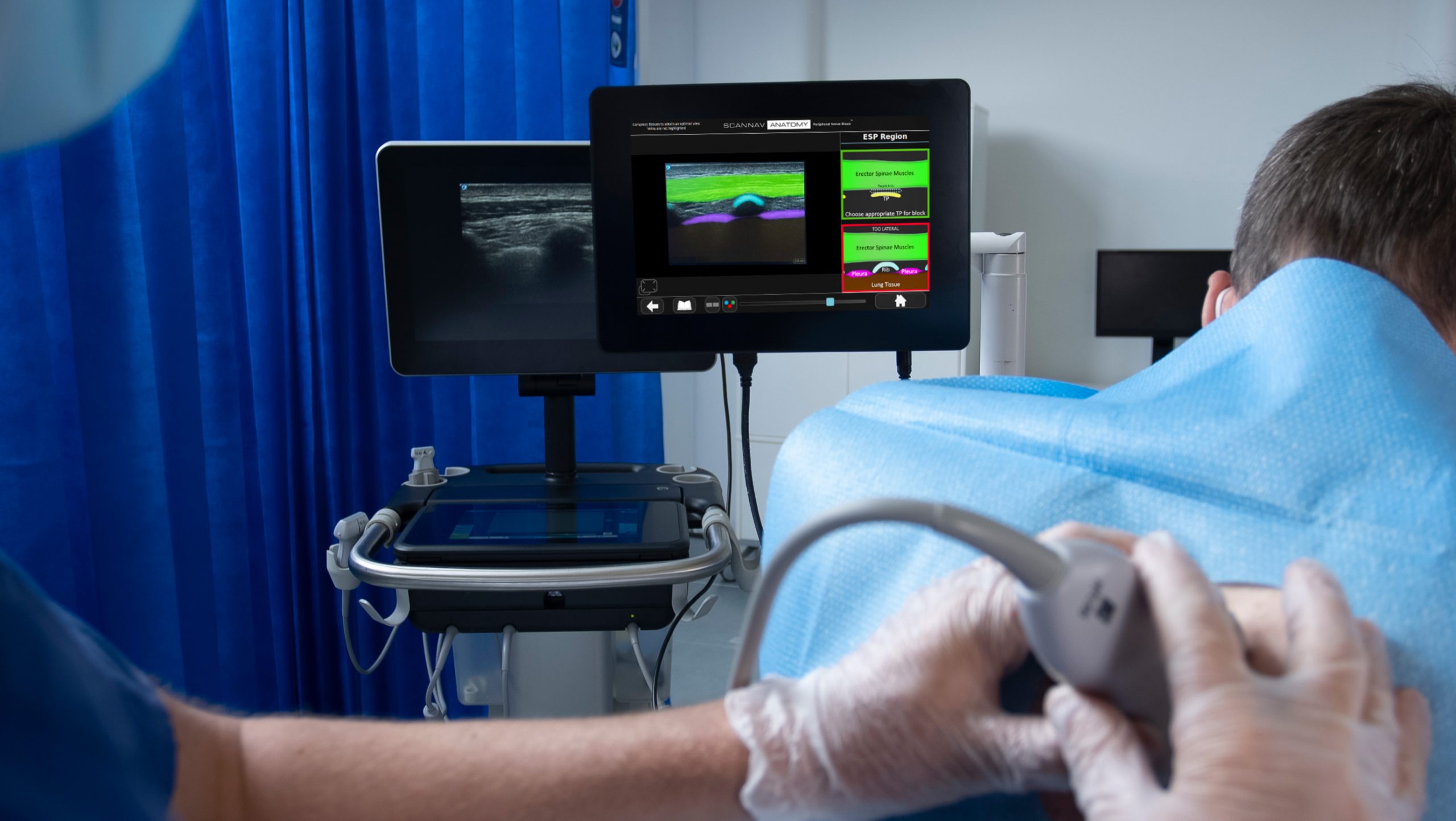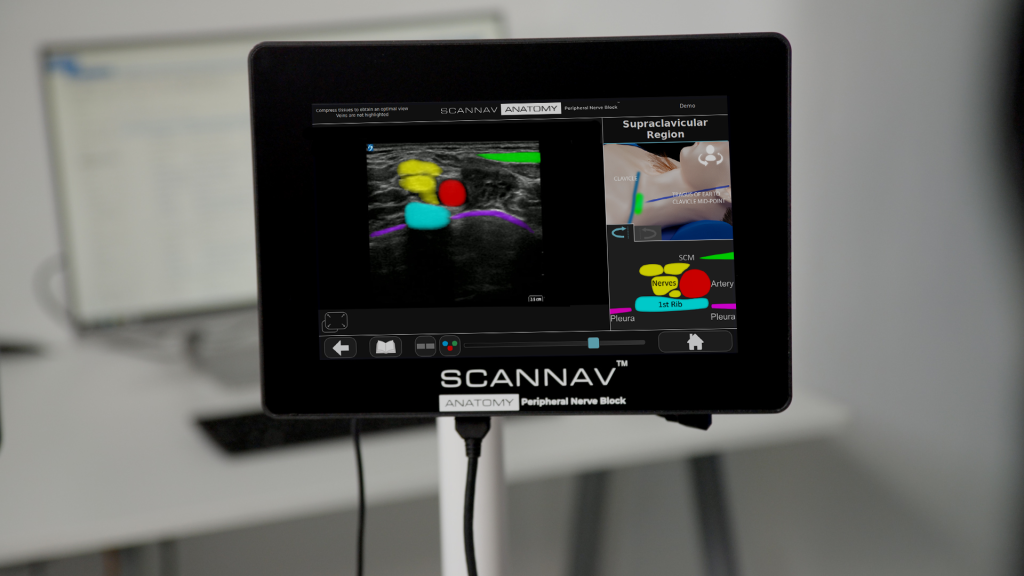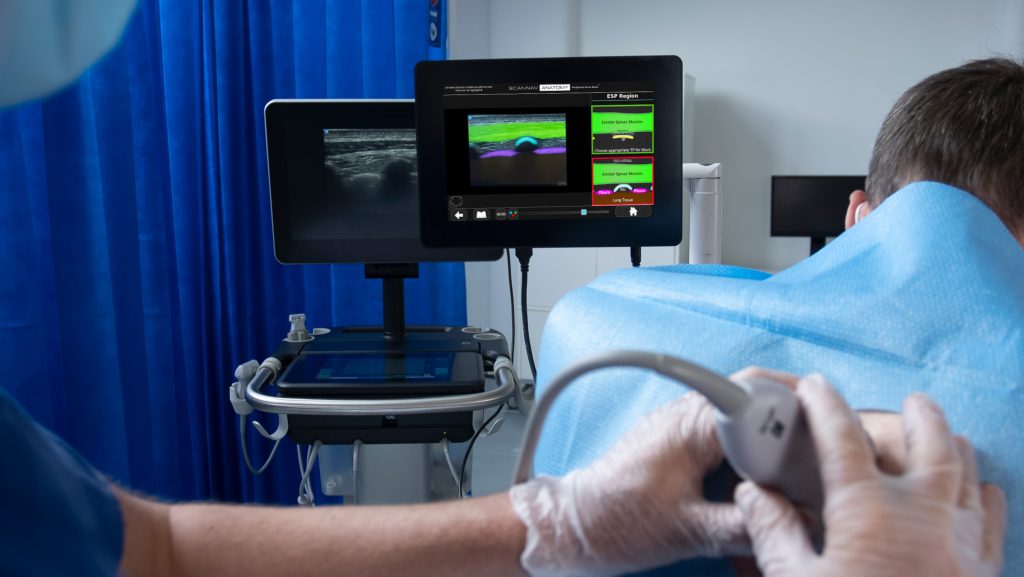
Revolutionizing Emergency Pain Management: The Role of ScanNav Anatomy PNB
In the fast-paced world of emergency medicine, every second counts, especially when it comes to managing pain in patients with extremity injuries or fractures. Traditional methods of pain management, such as systemic analgesia, have long been the norm. However, recent advancements in ultrasound-guided peripheral nerve blocks (PNBs) are revolutionizing the way pain relief can be approached in emergency situations. The integration of artificial intelligence (AI) into regional anesthesia, epitomized by ScanNav Anatomy PNB, heralds a new era of precision and efficiency in ultrasound guided PNBs, enhancing procedural success and patient satisfaction.
Introducing AI-assitance for PNBs
Ultrasound-assisted PNBs are effective in both pain management and primary anesthesia, with studies indicating elevated patient satisfaction levels and the potential to reduce opioid use 1 2. The versatility of ultrasound guided regional anesthesia and analgesia in emergency medicine ranges from extremity injuries to managing chronic pain and hip fractures in geriatric patients 3 4, making PNBs a valuable tool in the emergency care arsenal. Moreover, pre-hospital ultrasound guided PNBs conducted swiftly on trauma patients have demonstrated remarkable success; significantly reducing both the intensity and severity of pain in trauma patients compared to traditional systemic analgesia 5. However, research among consultants and specialists suggests low confidence in performing regional anesthesia competently 6. This underscores the importance of incorporating ultrasound guided PNB training into emergency medicine training programs and continuing medical education initiatives.
ScanNav Anatomy PNB is an AI-based system which highlights key anatomical structures for regional anesthesia and analgesia using real-time ultrasound. The cutting-edge technology uses deep learning to identify the structures on the ultrasound image as the clinician scans, assisting healthcare professionals in performing accurate and effective PNBs. This technology not only enhances the proficiency of novice practitioners but also serves as a valuable tool for experienced clinicians who deliver PNBs less frequently and are looking to develop their skills and confidence and improve patient outcomes. Recent research underscores the benefits of AI in anesthesia practice, with the potential to reduce complications, and enhance the success rate of regional anesthesia procedures 7. ScanNav Anatomy PNB, with its AI-driven assistive features, exemplifies this advancement, providing real-time guidance and feedback to support both novice and expert practitioners during training and clinical practice 8 9.


Enhanced training and AI-assistance
The key to the success of ultrasound-guided nerve blocks lies in precision and efficiency. Studies have shown that effective training programs can equip providers with the skills necessary to perform nerve blocks safely and proficiently 10. With ScanNav Anatomy PNB, emergency physicians have access to advanced technology, providing real-time AI assistance in training and clinical practice, improving the confidence and competence of physicians performing PNBs. Moreover, ScanNav Anatomy PNB has shown the potential to increase delivery of regional anesthesia in trauma cases 11, with the potential to reduce the risk of block failure and associated side effects (such as nerve injury) 12.
In conclusion, the use of ultrasound-guided peripheral nerve blocks are an effective way of delivering efficient pain relief to a wide range of patients seen in the emergency setting r, and with the support of technologies like ScanNav Anatomy PNB, emergency medicine physicians can become more competent and confident to perform PNBs in their everyday practice. By combining the expertise of emergency physicians with the precision of the latest technology, this technique offers superior efficacy, safety, and patient satisfaction compared to traditional methods. As the field continues to evolve, it is imperative that emergency care providers embrace ultrasound guided PNBs as a standard practice, utilizing the latest technology to ensure that patients receive the highest quality pain relief in their time of need.
Clinically validated, real-time AI-assistance for regional anesthesia and analgesia.
Realistic, safe & effective training system for Ultrasound-Guided Needling.
- Chin KJ, Chan V. Ultrasound-guided peripheral nerve blockade. Curr Opin Anaesthesiol. 2008 Oct;21(5):624-31. doi: 10.1097/ACO.0b013e32830815d1. PMID: 18784490. ↩︎
- Schulz-Stübner S. The critically ill patient and regional anesthesia. Curr Opin Anaesthesiol. 2006 Oct;19(5):538-44. doi: 10.1097/01.aco.0000245281.07411.f7. PMID: 16960488. ↩︎
- Li J, Szabova A. Ultrasound-Guided Nerve Blocks in the Head and Neck for Chronic Pain Management: The Anatomy, Sonoanatomy, and Procedure. Pain Physician. 2021 Dec;24(8):533-548. PMID: 34793642. ↩︎
- Gu J, Wang E, Dai S, Dong R, Xu F, Shen Z, Wang Z, He X. Ultrasound-guided Multiple Nerve Blocks: A Safe and Effective Anesthetic Modality in Geriatric Hip Fracture Patients. Clin J Pain. 2021 Dec 1;37(12):881-886. doi: 10.1097/AJP.0000000000000988. PMID: 34757340. ↩︎
- Büttner B, Mansur A, Kalmbach M, Hinz J, Volk T, Szalai K, Roessler M, Bergmann I. Prehospital ultrasound-guided nerve blocks improve reduction-feasibility of dislocated extremity injuries compared to systemic analgesia. A randomized controlled trial. PLoS One. 2018 Jul 2;13(7):e0199776. doi: 10.1371/journal.pone.0199776. PMID: 29965991; PMCID: PMC6028078. ↩︎
- Zhang X, Vanstone RJ, Turbitt L, West S, Harty E. Regional anaesthesia education for consultants and specialists in the UK: a mixed-methods analysis. Br J Anaesth. 2024 May;132(5):1073-1081. doi: 10.1016/j.bja.2024.01.032. Epub 2024 Mar 5. PMID: 38448267. ↩︎
- Bowness J, Varsou O, Turbitt L, Burkett-St Laurent D. Identifying anatomical structures on ultrasound: assistive artificial intelligence in ultrasound-guided regional anesthesia. Clin Anat. 2021 Jul;34(5):802-809. doi: 10.1002/ca.23742. Epub 2021 May 11. PMID: 33904628. ↩︎
- Bowness JS, El-Boghdadly K, Woodworth G, Noble JA, Higham H, Burckett-St Laurent D. Exploring the utility of assistive artificial intelligence for ultrasound scanning in regional anesthesia. Reg Anesth Pain Med. 2022 Jun;47(6):375-379. doi: 10.1136/rapm-2021-103368. Epub 2022 Jan 28. PMID: 35091395; PMCID: PMC9046753. ↩︎
- Bowness JS, Macfarlane AJR, Burckett-St Laurent D, Harris C, Margetts S, Morecroft M, Phillips D, Rees T, Sleep N, Vasalauskaite A, West S, Noble JA, Higham H. Evaluation of the impact of assistive artificial intelligence on ultrasound scanning for regional anaesthesia. Br J Anaesth. 2023 Feb;130(2):226-233. doi: 10.1016/j.bja.2022.07.049. Epub 2022 Sep 8. PMID: 36088136; PMCID: PMC9900732. ↩︎
- Ketelaars R, Stollman JT, van Eeten E, Eikendal T, Bruhn J, van Geffen GJ. Emergency physician-performed ultrasound-guided nerve blocks in proximal femoral fractures provide safe and effective pain relief: a prospective observational study in The Netherlands. Int J Emerg Med. 2018 Mar 2;11(1):12. doi: 10.1186/s12245-018-0173-z. PMID: 29500558; PMCID: PMC5834411. ↩︎
- Bowness JS, James K, Yarlett L, Htyn M, Fisher E, Cassidy S, Morecroft M, Rees T, Noble JA, Higham H. Assistive artificial intelligence for enhanced patient access to ultrasound-guided regional anaesthesia. Br J Anaesth. 2024 May;132(5):1173-1175. doi: 10.1016/j.bja.2023.08.004. Epub 2023 Sep 1. PMID: 37661562. ↩︎
- Bowness JS, Burckett-St Laurent D, Hernandez N, Keane PA, Lobo C, Margetts S, Moka E, Pawa A, Rosenblatt M, Sleep N, Taylor A, Woodworth G, Vasalauskaite A, Noble JA, Higham H. Assistive artificial intelligence for ultrasound image interpretation in regional anaesthesia: an external validation study. Br J Anaesth. 2023 Feb;130(2):217-225. doi: 10.1016/j.bja.2022.06.031. Epub 2022 Aug 18. PMID: 35987706; PMCID: PMC9900723. ↩︎


